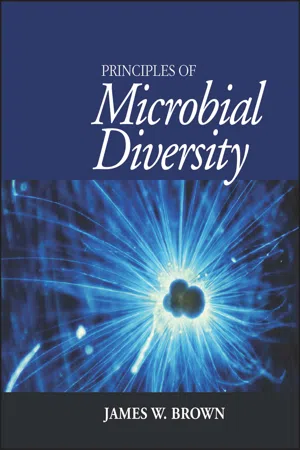
- English
- ePUB (mobile friendly)
- Available on iOS & Android
Principles of Microbial Diversity
About this book
Every speck of dust, drop of water, and grain of soil and each part of every plant and animal contain their own worlds of microbes.
Designed as a key text for upper-level undergraduates majoring in microbiology, genetics, or biology, Principles of Microbial Diversity provides a solid curriculum for students to explore the enormous range of biological diversity in the microbial world. Within these richly illustrated pages, author and professor James W. Brown provides a practical guide to microbial diversity from a phylogenetic perspective in which students learn to construct and interpret evolutionary trees from DNA sequences. He then offers a survey of the "tree of life" that establishes the necessary basic knowledge about the microbial world. Finally, the author draws the student's attention to the universe of microbial diversity with focused studies of the contributions that specific organisms make to the ecosystem.
Principles of Microbial Diversity fills an empty niche in microbiology textbooks by providing an engaging, cutting-edge view of the "microbial zoo" that exists around us, covering bacteria, archaea, eukaryotes, and viruses.
Frequently asked questions
- Essential is ideal for learners and professionals who enjoy exploring a wide range of subjects. Access the Essential Library with 800,000+ trusted titles and best-sellers across business, personal growth, and the humanities. Includes unlimited reading time and Standard Read Aloud voice.
- Complete: Perfect for advanced learners and researchers needing full, unrestricted access. Unlock 1.4M+ books across hundreds of subjects, including academic and specialized titles. The Complete Plan also includes advanced features like Premium Read Aloud and Research Assistant.
Please note we cannot support devices running on iOS 13 and Android 7 or earlier. Learn more about using the app.
Information

SECTION II
The Microbial Zoo
The Bacteria
Table of contents
- Cover
- Table of Contents
- Preface
- Acknowledgments
- About the Author
- SECTION I: Introduction to Microbial Diversity
- SECTION II: The Microbial Zoo
- SECTION III: Microbial Populations
- SECTION IV Conclusion: The Phylogenetic Perspective
- Index
- End User License Agreement